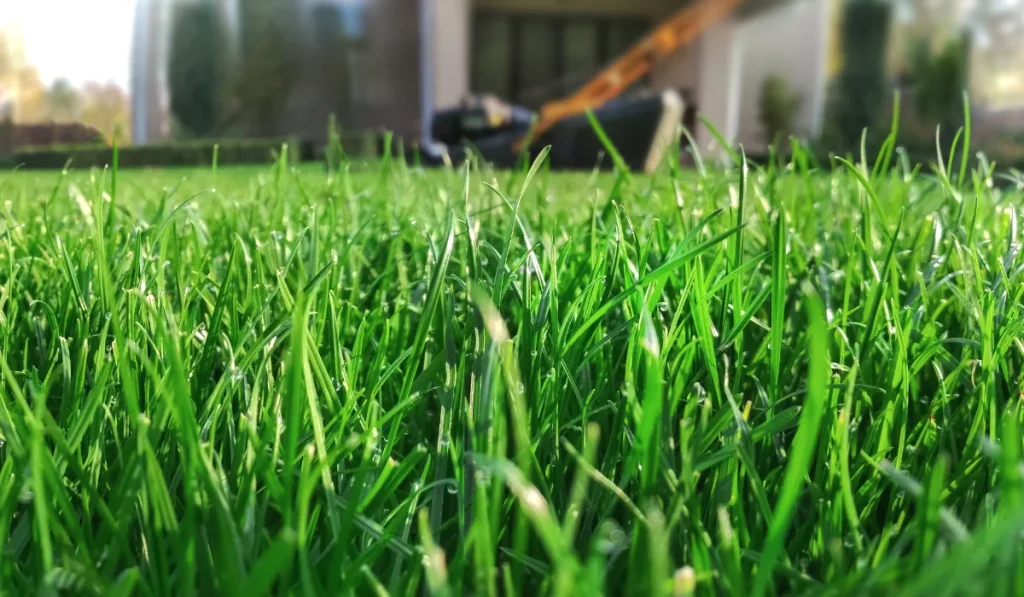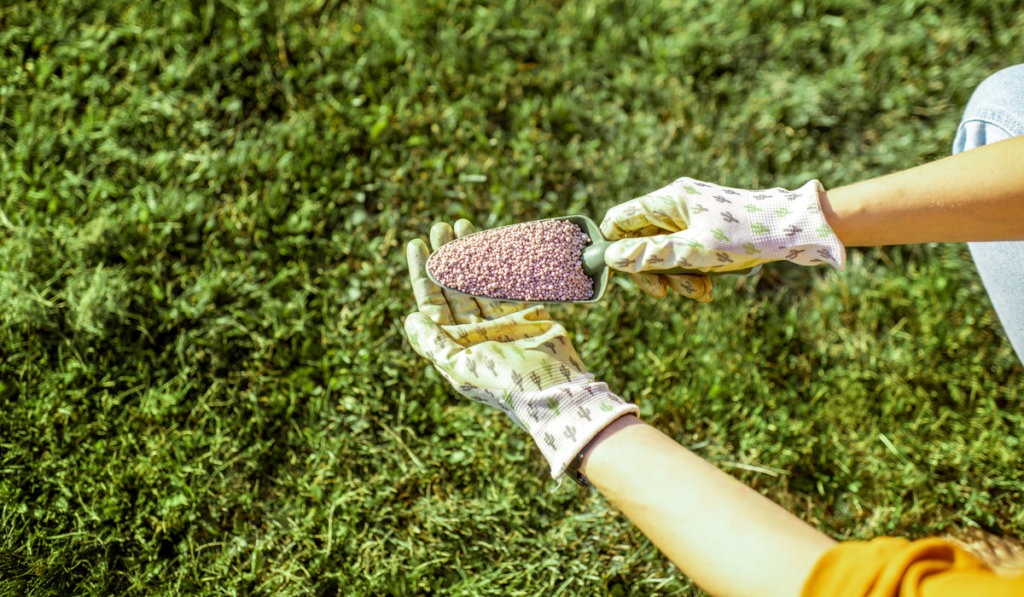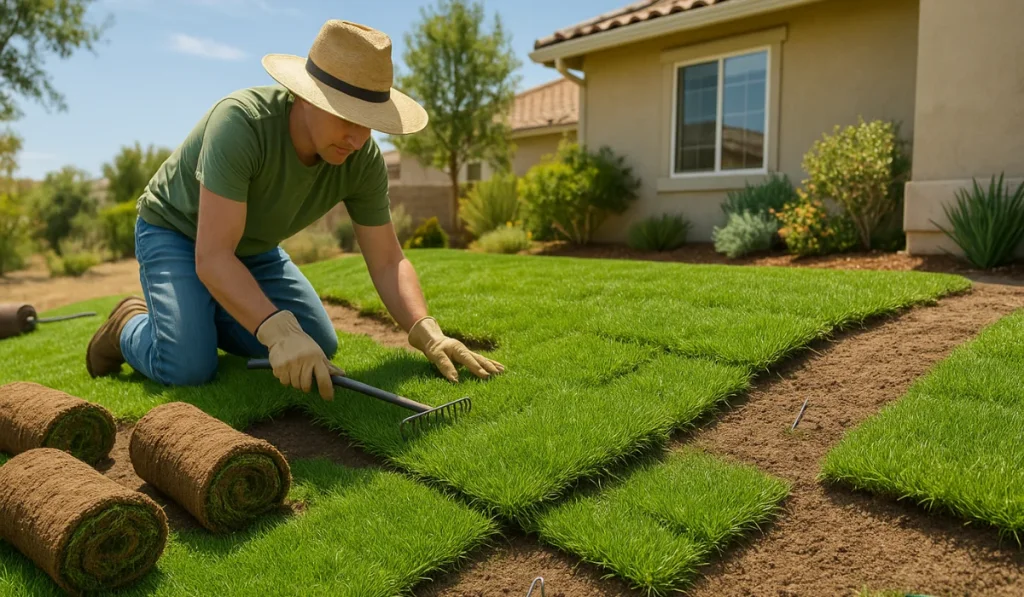These days, it seems like everyone is looking for ways to be more eco-friendly. And composting is a great way to do your part in reducing your carbon footprint. But did you know that there are tons of different ways to compost—that new innovations are being developed each and every day to automate our composting processes and to take “going green” to the next level?
In this post, we’ll explore 5 different composting innovations that are sure to change the future.
Key Takeaways
- Human composting, composting for space travel, composting robots, self-destructing plastic, and citywide composting hubs are five unique composting innovations that hold lots of promise for the future.
- While some of these ideas have yet to be brought to fruition, they provide a wonderful framework for environmental advances that will be undeniably beneficial in the years to come.
- Many of these are low-cost yet highly beneficial solutions to common dilemmas related to waste management.
1. Human Composting
While we don’t have a choice or say in how or when we die, we do have a choice in what happens to our bodies afterward. While cremation and burial are the two traditional options, there’s a new one on the horizon – human composting.
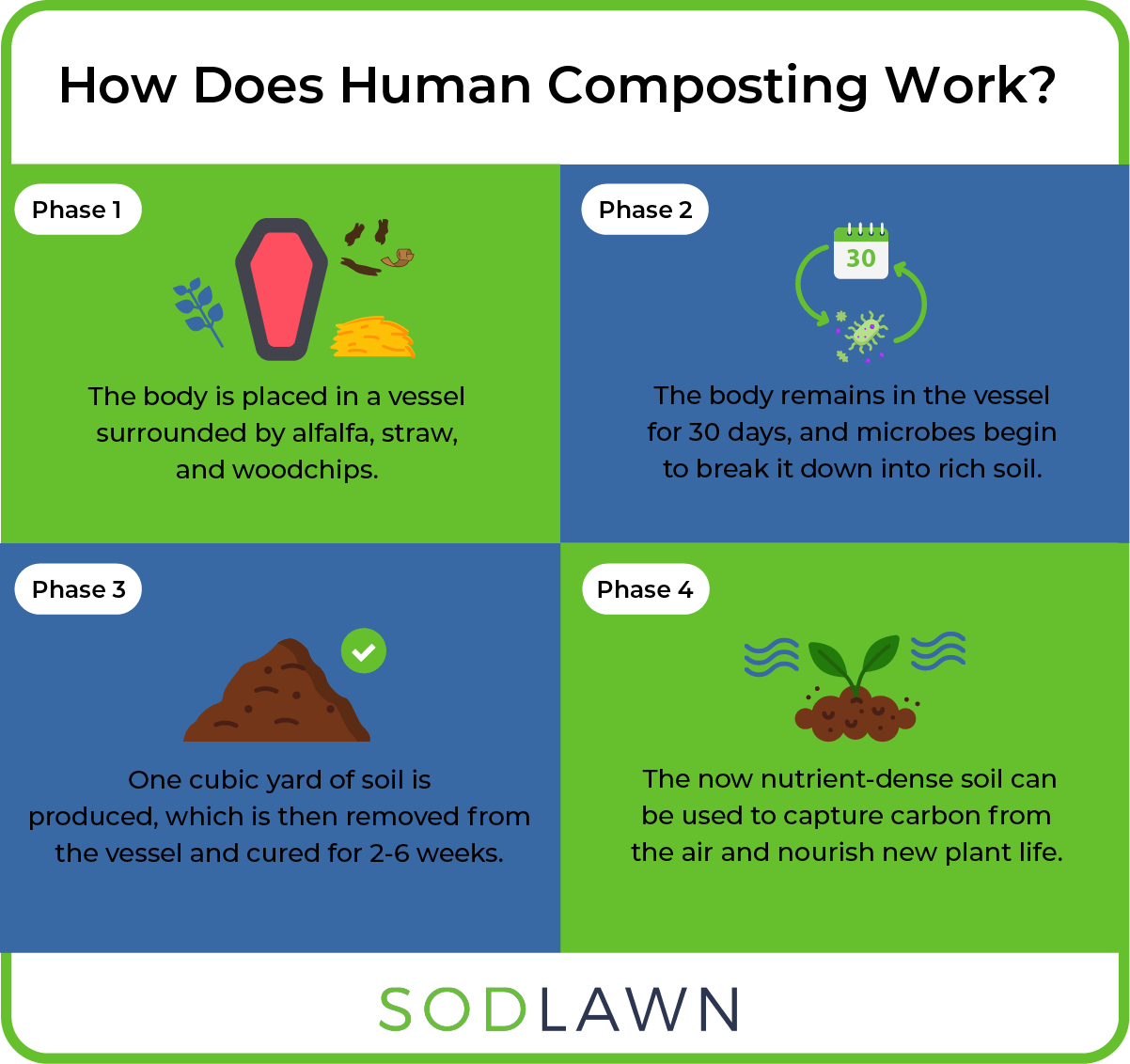
What Is Human Composting?
Human composting, also known as natural organic reduction, is a process where bodies are aerobically broken down into soil. The process is similar to how leaves and other organic matter decompose in yards and forests.
This disposal option is an alternative to conventional burial and cremation practices that have harmful environmental impacts. Composting requires 1/8 the energy of cremation. In addition, human composting strengthens the environment by returning essential nutrients back to the soil.
Consequently, human composting is both environmentally friendly and beneficial for the health of our natural surroundings.
Cremation/Burial and Its Impact on the Environment
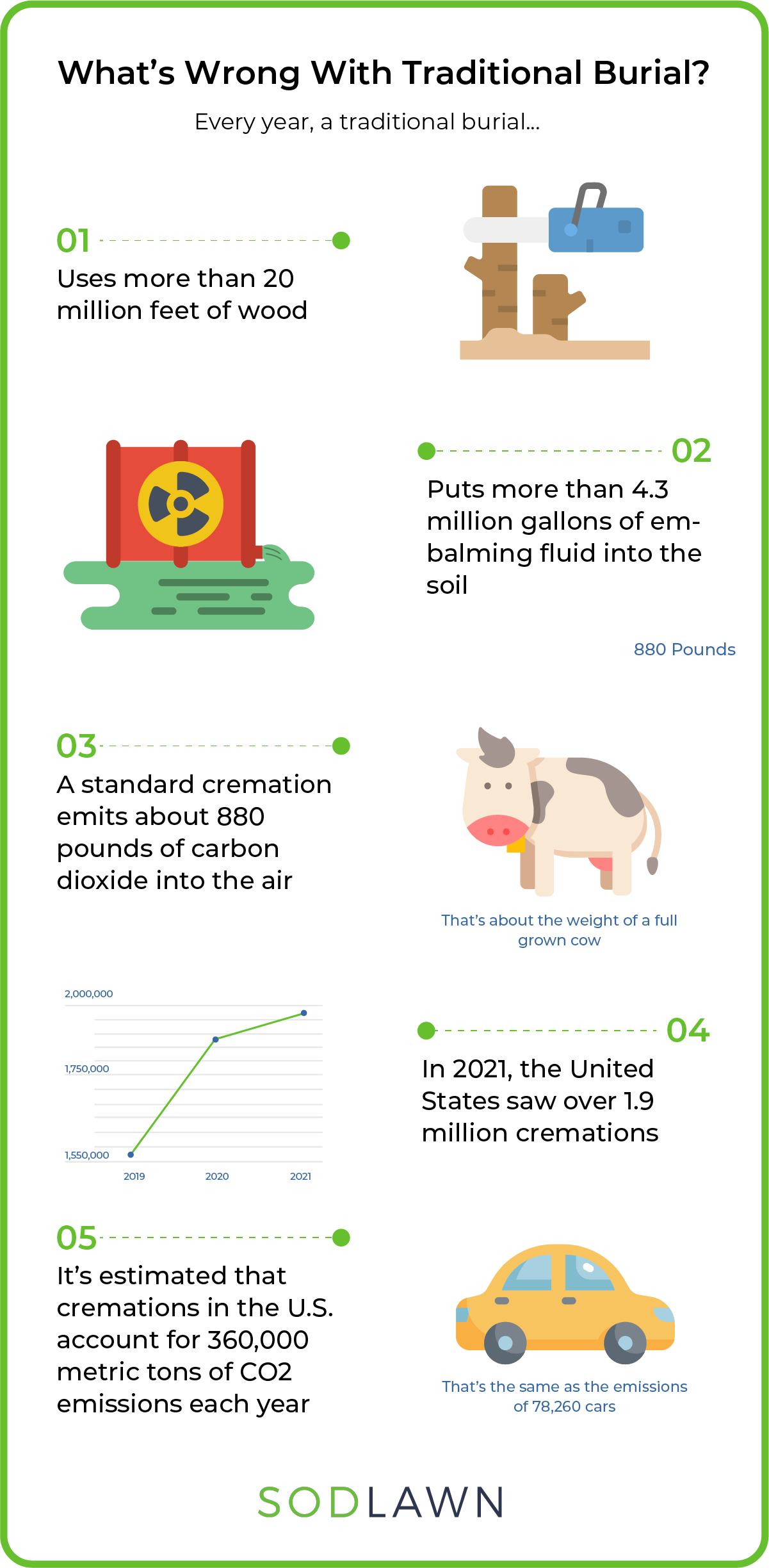
The contemporary practices of cremation and burial are environmentally troublesome. Every year, around 2.7 million people die in the United States alone, with almost all of them either cremated or buried in a conventional cemetery.
Here’s the problem with that.
Cremation requires the burning of fossil fuels, a process that releases carbon dioxide and harmful particulates into the atmosphere. Standard cremation emits roughly 880 lbs (or 400 kilograms) of carbon dioxide into the air. Carbon dioxide is one of the most problematic greenhouse gasses when it comes to global warming – and other pollutants like mercury and dioxins are released as well (particularly if the deceased being cremated had silver tooth fillings).
Burial, on the other hand, uses valuable land, pollutes soil, and contributes to climate change in and of itself because the process to manufacture and transport materials like grave liners, headstones, and caskets is incredibly resource-depleting.
According to the Green Burial Council, with a traditional burial, Americans put more than 20 million feet of wood, 4.3 million gallons of embalming fluids, and countless other tons of resources into the environment each year. This is not only a waste of precious resources but also costly and damaging, both in regards to the environment and to the wallet.
Where Is Human Composting Legal and Which States Might Be Next?
In the United States, the legal landscape of human composting is still very much in flux. As of right now, there are only three states where human composting is explicitly allowed: Washington, Oregon, and Colorado. California also recently passed Assembly Bill 351, which will legalize natural organic reduction beginning in 2027.
The specifics of how human composting works vary depending on the state. Oregon, for instance, is working on specialized human composting facilities. These facilities would be overseen by the state Department of Environmental Quality, and would be required to meet strict standards when it comes to safety and public health. If Oregon’s bill is successful, it could pave the way for other states to do likewise.
At present, there is a growing interest in human composting as an environmentally friendly alternative to traditional burial or cremation practices.
Several states are currently considering bills that would allow for human composting, also known as “natural organic reduction.” These include Massachusetts, Delaware and New York.
There are plenty of good reasons for legislators to consider this move, though. Proponents argue that it reduces our carbon footprint, saves precious resources like water and land, and can even provide nutrients for plants and trees.
Given these potential benefits, it’s likely that we’ll see more states jumping on board in the near future.
What Could This Mean for the Future of Burial?
The process of decomposition is a natural and essential part of the life cycle. Nutrients in dead plants and animals are recycled back into the soil, where they can be used to support new life.
However, the modern practice of burial or even cremation often interrupts this process. By encasing bodies in concrete vaults or metal coffins, we prevent them from decomposing naturally. As a result, valuable nutrients are lost, and valuable land is taken up by cemeteries.
Human composting offers a more sustainable alternative to traditional burial practices. By using the process of decomposition to return nutrients to the earth, human composting can help to support new life and preserve precious resources.
In addition, human composting can help us to shift our perspective on death. Rather than seeing it as an end, human composting reminds us that death is simply a part of the cycle of life.
As we return our bodies to the earth, we can find a greater sense of unity with the natural world—and find more peace with and respect for the process of death.
2. Composting on Mars
On Earth, microorganisms help break down the organic waste in our compost piles. However, these organisms need oxygen to survive, which is not always readily available in space or on Mars.
Composting looks a little different in space, but recent innovations have made the process entirely possible.
Let’s take a closer look.
MEliSSA (Micro-Ecological Life Support System Alternative)
The Micro-Ecological Life Support System Alternative (MELiSSA) is a closed-loop ecosystem designed to recycle wastes into oxygen, water, and food for long-term human space missions. This project, conducted by the European Space Agency, could have a major impact on space travel as well as life here on Earth.
The goal of the project is to create a system that can recycle all of the waste products generated by a crew of astronauts, using only plants and microorganisms.
There are four main compartments, or components, as described in greater detail below.
Together, these four units form a self-sustaining ecosystem that can recycle wastes into resources, providing everything astronauts need to survive in space. While MELiSSA is still in the early stages of development, it holds great promise as a sustainable life support system for future space missions.
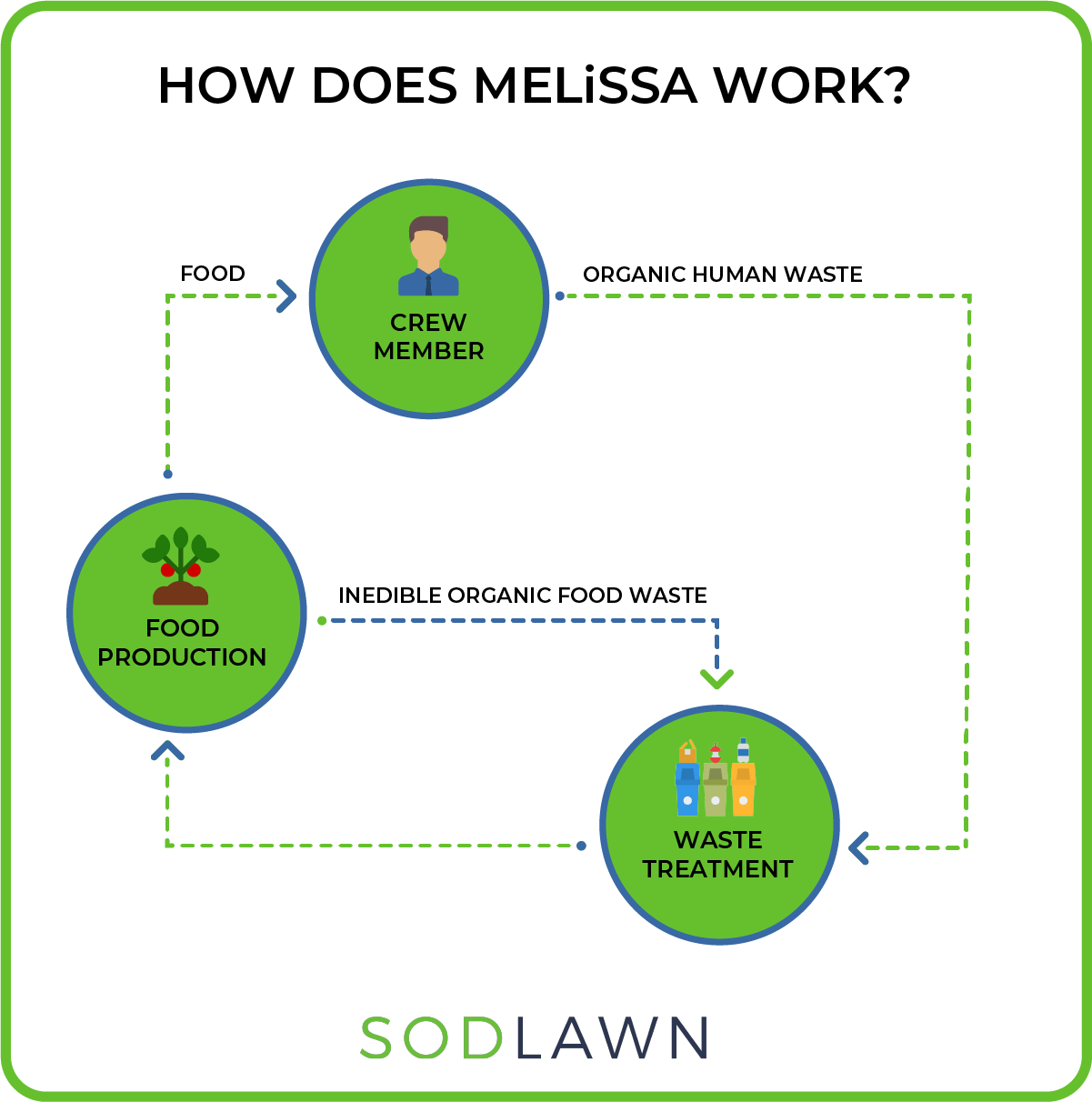
The Liquefying Compartment
The liquefying compartment breaks down complex organic polymers into simpler molecules (volatile fatty acids, ammonium, carbon dioxide, etc.). This process is essential for the proper functioning of MEliSSA and helps to prevent the build-up of waste products in the system. In addition, the liquefying compartment provides a source of nutrients for the other compartments in the system.
The Photoheterotrophic Compartment
The photoheterotrophic compartment is responsible for the elimination of end products from the liquefying compartments. This is achieved through a process of anaerobic digestion (the bacterial breakdown of organic matter in the absence of oxygen), which produces methane gas that can be used as fuel.
The Nitrifying Compartment
Another goal of MEliSSA is to find a way to sustain human life in space by recycling urine and sweat back into water and food in a way that does not pose a risk to the astronauts.
Urine contains nitrogen, which is essential for plant growth, so the urine is routed into a nitrifying compartment. In this compartment, bacteria Nitrosomonas and Nitrobacter transform the urine into nitrites and then nitrates.
The nitrates are then used to cultivate plants and microalgae, which provide food and oxygen for the astronauts. The process of transformation for the urine also removes any toxic chemicals that might be harmful to other parts of the system.
Overall, MEliSSA is working to develop a closed loop system where urine and sweat are recycled back into water and food, providing everything astronauts need to sustain life in space.
The Photoautotrophic Compartment
In the final compartment, the photoautotrophic compartment, several benefits can be found. It can be further split into two parts: the “algae” compartment, which is colonized by the cyanobacterium Arthrospira platensis, and the higher plant compartment, where plants containing lignin material can conduct water and minerals throughout the plant.
Together, these compartments ensure that oxygen can be regenerated and food can be produced, even in space.
Algae is essential—particularly this specific cyanobacteria species—for several reasons. For one, it has a high protein content, and it’s already an established part of the human diet here on earth. It has a high pH in culture, too, which reduces the likelihood of contamination.
In the higher plant compartment, research has been done so far with eight crops: spinach, potatoes, tomatoes, wheat, soybeans, rice, onions, and lettuce. Environmental considerations like light and nutrients are taken into account, all with the goal of investigating how the production of these plants can be done with nutrients from composted ingredients.
What Could This Mean for the Future of Space Travel?
As we continue to explore and colonize space, one of the challenges we face is how to deal with our waste. In a closed environment like a space station or spaceship, recycling refuse is essential for sustainability.
And while there are already methods for recycling some types of waste, organic waste has been more difficult to deal with. However, recent developments in composting technologies could change that.
Composting could enable us to create a closed-loop system in space, where all of our organic waste is reused. This would not only be more sustainable, but it would also save on resources.
And what about when you die in space? The idea of composting human remains, as described earlier in this post, could also prove to be a viable option on Mars. Further, new research into the process of dissolving proteins of the human body and leaving behind just bone and liquid could have implications for life here on Earth.
The liquid produced could be used to provide nutrients to growing plants on Mars, helping to extend their life cycle.
What’s more, human composting could also have applications here on Earth. If we can create a system that efficiently recycles organic waste in space, why can’t we do the same here? This could have a major impact on reducing greenhouse gas emissions and combating climate change. So while human composting might just be helping us thrive in space, it could also be playing a role in saving our planet.
3. Composting Robots on Farms
In recent years, there has been a growing interest in composting as a way to reduce waste and create nutrient-rich soil for gardens and farms.
However, the process of composting can be time-consuming and labor-intensive, making it difficult for busy farmers to keep up with the demand.
Fortunately, robots are beginning to play a role in automating the composting process.
By using sensors and machine learning, these robots are able to identify which materials are suitable for composting and then mix them together in the right proportions. The result is a nutrient-rich compost that can be used to improve crop yields and help farmers save time and money.
There are also manure-collecting robots that can scoop manure from the barn floor to be deposited in a composting system.
As more farmers adopt these technologies, it is likely that we will see even more advances in the field of automated composting.
Manure Collecting Robots
In recent years, there has been an increasing focus on the environmental impact of agriculture. One of the key areas of concern is the impact of animal waste on air and water quality. Animal manure can contain harmful bacteria and chemicals, and when it is flushed into waterways, it can pollute the water and damage delicate ecosystems.
A single cow can produce an average of 54 pounds of manure each day–or 12 tons a year. That’s a lot of manure going back into the environment. Yet cow manure is nutrient-dense, containing around 10 lbs of nitrogen per ton. It’s a fantastic fertilizer—if it’s properly composted.
The problem is that the process of collecting this waste and turning it into compost is time-consuming. Enter technology.
Some farmers are turning to manure-collecting robots to help reduce the environmental impact of their operations. These robots collect solid waste from barns and stalls before turning it into compost that can be applied back to the land. This process not only helps to reduce pollution, but it also helps to improve soil quality.
The robots don’t just push the manure around; they pick it up. Unlike traditional methods of barn cleaning that require a farmer to handle the manure multiple times (scraping it out and then removing it with a front end loader or tractor), this method is a completely hands-off process.
Traditionally, cow manure has been removed through the highly labor-intensive processes described above, or by washing it out with a high volume of water.
The robots can be used on floors of any kind, including slabs, rubber, and more. It’s even suitable for barns with sawdust or deep litter packs. It can be used for various types of manure, too—and not just cow manure.
One farmer, John Taylor of Bivalve Dairy, has completely eliminated flushing, helping to save water that’s in short supply during a drought. This saves money and tens of thousands of gallons of water.
Water is in short supply in many places throughout the world, but especially in states like California, which is currently experiencing its worst drought in more than 1000 years.
With this system, more carbon is being sequestered into the ground, improving soil health and allowing farmers like Taylor to produce more nutrient-dense feed to give to his cattle—all without the use of synthetic fertilizers that further damage the environment.
What Could This Mean for the Future of Farming?
Composting robots like these could have a major impact on the future of farming.
Not only will they help farmers conserve resources and save money in a hands-off way, helping to save time as well, but they’ll also allow them to explore an additional revenue stream in addition to milk and meat production: compost production.
Compost is referred to as “black gold” in gardening circles. In some cases, farmers may be able to make more money selling compost than they do selling meat or milk.
And of course, the two work in tandem with each other, meaning farmers could potentially use far less land, water, and resources to make the same amount of profit in the future.
4. Self-Destructing Plastic
It’s no secret that plastic pollution is a major environmental problem. Every year, millions of tons of plastic waste end up in landfills, oceans, and other ecosystems, where it can cause serious harm to plants and animals.
One promising solution to this problem is water-soluble bioplastics.
Water-Soluble Bioplastics
Plastic is in just about everything, from the packaging for the food we buy to the cars we drive and even the clothes we wear.
The problem with plastic is that it doesn’t break down well at all. In fact, according to the World Economic Forum, “In 2019, the CIEL estimated that production and incineration of plastic would add 850 million metric tons of greenhouse gasses to the atmosphere – equivalent to 189 coal-fired power plants. By 2050 this could rise to 2.8 gigatons of carbon dioxide per year – or 615 coal plants’ worth.”
Those are a lot of resources. And with about 4-8% of annual global oil consumption associated with the production of plastics, it’s clear that things are only going to get worse. If our dependency on plastics continues, they will account for about 20% of our oil consumption by 2050.
To break this dependency and create a more sustainable, closed-loop system, scientists are experimenting with water-soluble bioplastics. These are plastics that can be broken down with water and heat, rather than sitting in a landfill for many centuries (after all, plastic takes anywhere from 20 to 500 years to decompose, depending on the structure and form).
If the idea of composting plastic sounds complex, like something you might find only in a laboratory, think again. It’s a technology that’s so accessible that many scientists think it could become something that consumers do at home for themselves.
These water-soluble, biodegradable plastics are different from ones that have been developed in the past. The “old fashioned” recyclable plastics are made of the polyester known as polylactic acid. While they’re touted as being compostable, they still end up in landfills and last almost as long as regular plastics.
Scientists at the University of California, Berkeley have created a method of dissolving these compostable plastics with water and heat, a process that takes just a couple of weeks.
What Could This Mean for the Future of Plastic Waste?
This new technology of biodegradable plastics isn’t just beneficial for compostable plastics; it could also be applicable to other kinds of polyester plastics. This might allow for the creation of compostable plastic containers and other products.
This quick degradation process would work well with most municipal composting systems, in which it takes just 90 days or less to turn food and plant matter into usable compost.
Not only that, but this so-called “programmed degradation” could be the key to unlocking new technologies that could be used to help us recycle all kinds of other objects. From biodegradable glue used in electronics to automobiles, this self-destructing plastic could be the stuff of the future.
5. City-Based Composting Hubs
In the United States, food waste alone generates the same amount of greenhouse gas emissions as 37 million cars, according to the National Resources Defense Council.
A final composting innovation that’s sure to change the way we think about recycling and waste disposal of this kind of waste—particularly in urban environments—is the city-based composting hub.
These can be incredibly beneficial, particularly in large cities like New York City which produces more than 14,000,000 tons of trash a year. Most of this has to be bussed out of the city, taking an enormous environmental and monetary toll (the latter to the tune of $300 million per year).
City-based composting hubs offer a good solution to this problem, reducing waste-related traffic (i.e., garbage trucks moving in and out of the city) and therefore, noise pollution and greenhouse gas emissions.
Floating composting waterfront hubs, as imagined by Present Architects in 2014, would provide a much-needed service for New York City.
In New York City, the city-based composting hub concept is referred to as the Green Loop. The idea is this: a waterfront hub that is a street-level composting facility with an elevated park on top. There would be additional proposed hubs stationed along the city’s waterways to get rid of waste.
With a network capacity of 50% of the city’s annual waste, or roughly 1 million tons per year, these hubs would be able to significantly reduce the number of truck miles used to take waste to landfills. In addition, addressing borough equity would be an important priority for these hubs.
By providing this service to all boroughs, they would be able to help reduce environmental inequities that exist within the city in their own individual ways.
This would make garbage disposal much more localized, and if each borough were to host its own transfer station, it could add more than a hundred acres of public park land and create a brand-new market for compost—a nutrient-rich resource that typically has to be trucked into the city for people to buy.
How exactly does it work?
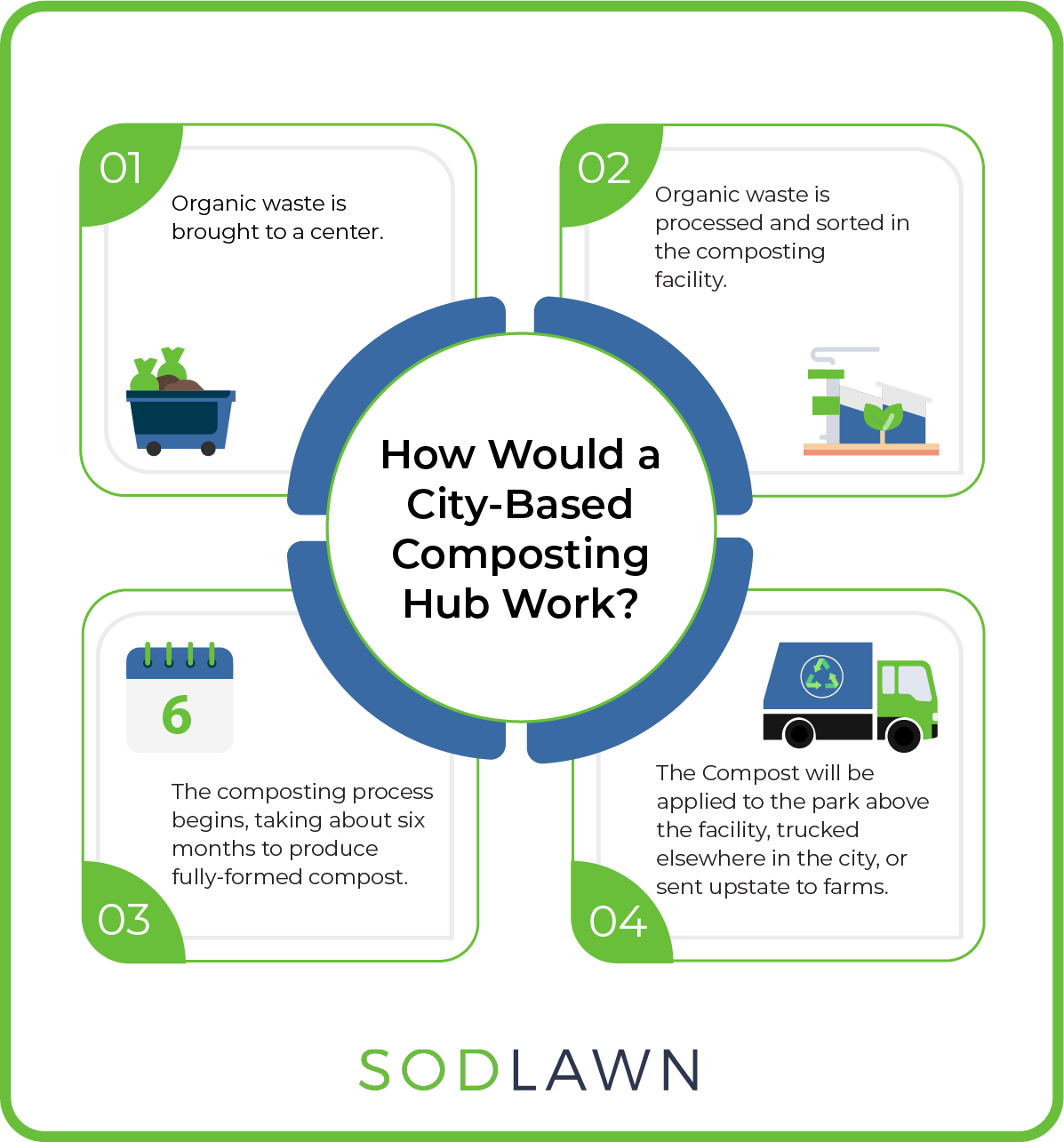
Waste is brought into one of these centers, where it is then processed and sorted on the street level beneath the park. Then, it will take about six months to produce the fully formed compost, some of which would be transferred up onto the rooftop into the park, and some of which could be used in other areas.
It could be trucked around the city to fertilize green roofs or existing parks, or it could be barged up the Hudson River to head upstate, where farms could use it to fertilize their fields. The idea is that these composting hubs would be able to handle 30% of all residential waste, or all organic waste, with a goal of eventually breaking down or reusing 100% of all residential organic waste.
The downside to this plan? It hasn’t quite made it to fruition yet. As of writing this article in 2022, hubs like this have yet to make it off the blueprint. Why?
It’s complicated, but state bureaucracy and the highly politicized nature of environmental movements like this tend to sow division. Many politicians posit that environmentalism and business don’t go hand in hand, but the reality is that they can, if only the right technologies are used.
Nevertheless, they offer an idea of what the future might hold and give similar cities with similar problems a framework and potential solution to tap into in addressing their own waste management concerns.
And it’s not all a fairytale, either. In fact, much of the planning for this project was inspired by a major composting facility in Edmonton, Canada, which is a large enough center to be able to handle most of the city’s organic waste. Unfortunately, this center sits on the outskirts of the city, many miles away from people—still requiring truck miles to get the waste where it needs to be.
What Could This Mean for the Future of Waste Infrastructure?
It’s no secret that more and more people are interested in doing their part to reduce (or reuse) organic household waste. These city composting hubs are a great solution to cut down on how much waste goes into the landfills.
Many states, including Vermont and soon, New York, have mandatory composting laws in place in which all organic household waste (like kitchen scraps) must be composted. It cannot go into the landfill.
The number of communities that offer some form of composting has grown by more than 65% in the last five years, rising to meet the demand for these composting services.
Not all cities have public composting programs, but for those that do or are looking to initiate one, these city-wide hubs hold a lot of promise for waste infrastructure.
And the best news of all? This kind of composting is, at its core, incredibly simple, requiring very little in the way of infrastructure or advanced technology.
Rich Flammer, Principal at Hidden Resources, says, “Composting technology continues to develop, yet a professionally-run facility doesn’t need a lot of technology. It’s a biological process that can be managed at any scale with a knowledge of the key principles of the science and art of composting. It’s not complicated, just management-intensive.”
Essentially, if there’s a will, there’s a way when it comes to composting, and as you can see, there is definitely a will.
The Bottom Line
As the world becomes increasingly aware of the need to reduce waste and protect the environment, a number of innovative new composting technologies are being developed.
As you may have gathered from reading the information in this post, the ultimate goal of research and innovation in composting should be not just to reduce our waste, but to find ways to turn that waste into something usable—something that could potentially feed our planet.
According to Flammer, “A really important approach is to design and implement programs that follow a hierarchy that focus on reducing the generation of organic materials that are composted or landfilled. Wasting less food, donating food to food banks, and feeding it to livestock are highest on the pyramid. Then home and onsite composting come next, and centralized facilities follow. All important, but we need to exhaust all options for source reduction and feeding people first.”
The problem that will remain both now and long into the future is that recycling, composting, and resource management are all highly politicized, hot-button topics.
That’s unfortunate, since the resources we share, from food to soil, water to air, serve all of us. We all need these resources to survive and thrive.
“How we sustain this health, or more aptly, reverse the damage already done, is up for debate,” Flammer says, “but we have to do something, and composting definitely plays a substantial role.”
These are just a few examples of the innovative new composting technologies that are sure to change the future. With continued development, these technologies could help to make a significant impact on the environment and the way we live our lives—if only we let them.

